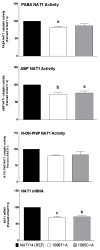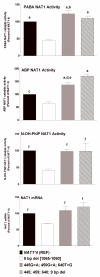Functional effects of genetic polymorphisms in the N-acetyltransferase 1 coding and 3' untranslated regions
- PMID: 21290563
- PMCID: PMC3252750
- DOI: 10.1002/bdra.20763
Functional effects of genetic polymorphisms in the N-acetyltransferase 1 coding and 3' untranslated regions
Abstract
Background: The functional effects of N-acetyltransferase 1 (NAT1) polymorphisms and haplotypes are poorly understood, compromising the validity of associations reported with diseases, including birth defects and numerous cancers.
Methods: We investigated the effects of genetic polymorphisms within the NAT1 coding region and the 3'-untranslated region (3'-UTR) and their associated haplotypes on N- and O-acetyltransferase catalytic activities, and NAT1 mRNA and protein levels following recombinant expression in COS-1 cells.
Results: 1088T>A (rs1057126; 3'-UTR) and 1095C>A (rs15561; 3'-UTR) each slightly reduced NAT1 catalytic activity and NAT1 mRNA and protein levels. A 9-bp (TAATAATAA) deletion between nucleotides 1065 and 1090 (3'-UTR) reduced NAT1 catalytic activity and NAT1 mRNA and protein levels. In contrast, a 445G>A (rs4987076; V149I), 459G>A (rs4986990; T153T), and 640T>G (rs4986783; S214A) coding region haplotype present in NAT1*11 increased NAT1 catalytic activity and NAT1 protein, but not NAT1 mRNA levels. A combination of the 9-bp (TAATAATAA) deletion and the 445G>A, 459G>A, and 640T>G coding region haplotypes, both present in NAT1*11, appeared to neutralize the opposing effects on NAT1 protein and catalytic activity, resulting in levels of NAT1 protein and catalytic activity that did not differ significantly from the NAT1*4 reference.
Conclusions: Because 1095C>A (3'-UTR) is the sole polymorphism present in NAT1*3, our data suggest that NAT1*3 is not functionally equivalent to the NAT1*4 reference. Furthermore, our findings provide biologic support for reported associations of 1088T>A and 1095C>A polymorphisms with birth defects.
Copyright © 2011 Wiley-Liss, Inc.
Figures




Similar articles
-
Functional effects of single nucleotide polymorphisms in the coding region of human N-acetyltransferase 1.Pharmacogenomics J. 2008 Oct;8(5):339-48. doi: 10.1038/sj.tpj.6500483. Epub 2007 Oct 2. Pharmacogenomics J. 2008. PMID: 17909564 Free PMC article.
-
Functional analysis of arylamine N-acetyltransferase 1 (NAT1) NAT1*10 haplotypes in a complete NATb mRNA construct.Carcinogenesis. 2012 Feb;33(2):348-55. doi: 10.1093/carcin/bgr273. Epub 2011 Nov 22. Carcinogenesis. 2012. PMID: 22114069 Free PMC article.
-
NATb/NAT1*4 promotes greater arylamine N-acetyltransferase 1 mediated DNA adducts and mutations than NATa/NAT1*4 following exposure to 4-aminobiphenyl.Mol Carcinog. 2012 Aug;51(8):636-46. doi: 10.1002/mc.20836. Epub 2011 Aug 11. Mol Carcinog. 2012. PMID: 21837760 Free PMC article.
-
Structure-function analyses of single nucleotide polymorphisms in human N-acetyltransferase 1.Drug Metab Rev. 2008;40(1):169-84. doi: 10.1080/03602530701852917. Drug Metab Rev. 2008. PMID: 18259988 Free PMC article. Review.
-
Arylamine N-acetyltransferases: structural and functional implications of polymorphisms.Toxicology. 2008 Dec 30;254(3):170-83. doi: 10.1016/j.tox.2008.08.022. Epub 2008 Sep 12. Toxicology. 2008. PMID: 18852012 Review.
Cited by
-
Human N-Acetyltransferase 1 and 2 Differ in Affinity Towards Acetyl-Coenzyme A Cofactor and N-Hydroxy-Arylamine Carcinogens.Front Pharmacol. 2022 Feb 25;13:821133. doi: 10.3389/fphar.2022.821133. eCollection 2022. Front Pharmacol. 2022. PMID: 35281898 Free PMC article.
-
Humans and Chimpanzees Display Opposite Patterns of Diversity in Arylamine N-Acetyltransferase Genes.G3 (Bethesda). 2019 Jul 9;9(7):2199-2224. doi: 10.1534/g3.119.400223. G3 (Bethesda). 2019. PMID: 31068377 Free PMC article.
-
Acetylation of putative arylamine and alkylaniline carcinogens in immortalized human fibroblasts transfected with rapid and slow acetylator N-acetyltransferase 2 haplotypes.Arch Toxicol. 2021 Jan;95(1):311-319. doi: 10.1007/s00204-020-02901-4. Epub 2020 Nov 2. Arch Toxicol. 2021. PMID: 33136180 Free PMC article.
-
K-variant BCHE and pesticide exposure: Gene-environment interactions in a case-control study of Parkinson's disease in Egypt.Sci Rep. 2018 Nov 8;8(1):16525. doi: 10.1038/s41598-018-35003-4. Sci Rep. 2018. PMID: 30410011 Free PMC article.
-
Rapid birth-and-death evolution of the xenobiotic metabolizing NAT gene family in vertebrates with evidence of adaptive selection.BMC Evol Biol. 2013 Mar 7;13:62. doi: 10.1186/1471-2148-13-62. BMC Evol Biol. 2013. PMID: 23497148 Free PMC article.
References
-
- Ambrosone CB, Abrams SM, Gorlewska-Roberts K, Kadlubar FF. Hair dye use, meat intake, and tobacco exposure and presence of carcinogen-DNA adducts in exfoliated breast ductal epithelial cells. Arch Biochem Biophys. 2007;464:169–175. - PubMed
-
- Bell DA, Stephens EA, Castranio T, Umbach DM, Watson M, Deakin M, Elder J, Hendrickse C, Duncan H, Strange RC. Polyadenylation polymorphism in the acetyltransferase 1 gene (NAT1) increases risk of colorectal cancer. Cancer Res. 1995;55:3537–3542. - PubMed
-
- Bruhn C, Brockmoller J, Cascorbi I, Roots I, Borchert HH. Correlation between genotype and phenotype of the human arylamine N-acetyltransferase type 1 (NAT1) Biochem Pharmacol. 1999;58:1759–1764. - PubMed
-
- Carmichael SL, Shaw GM, Yang W, Iovannisci DM, Lammer E. Risk of limb deficiency defects associated with NAT1, NAT2, GSTT1, GSTM1, and NOS3 genetic variants, maternal smoking, and vitamin supplement intake. Am J Med Genet A. 2006;140:1915–1922. - PubMed
-
- Chen B, Zhang WX, Cai WM. The influence of various genotypes on the metabolic activity of NAT2 in a Chinese population. Eur J Clin Pharmacol. 2006;62:355–359. - PubMed
Publication types
MeSH terms
Substances
Grants and funding
LinkOut - more resources
Full Text Sources
Medical

